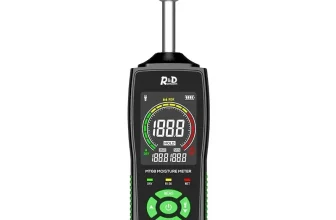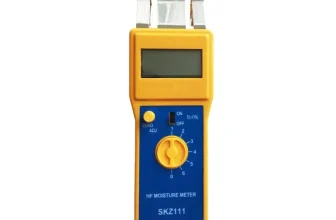A Hay Moisture Probe, as the name implies, is a device designed
specifically to measure the moisture content in hay. At its core, this
agricultural tool serves a pivotal role in ensuring the quality, safety,
and longevity of hay – an essential livestock feed. The probe is usually
inserted into bales of hay, allowing farmers to determine if the
moisture levels are within the ideal range for preventing spoilage or
even spontaneous combustion. Understanding and managing moisture levels
helps farmers significantly in achieving optimum conditions for hay
storage, thereby securing both the quality and quantity of the feed they
produce.
Importance
of moisture monitoring in hay production
Moisture monitoring in hay production holds significant importance
for several compelling reasons. Firstly, it plays a role in preserving
the quality of the hay. Hay that’s been baled with a high moisture
content can lead to the growth of mold, ruining the hay’s nutritional
quality and potentially posing a health risk to animals that consume
it.
Secondly, moisture monitoring can help prevent financial losses.
Overly moist hay doesn’t just risk quality issues; it can also lead to
spontaneous combustion when stored, a serious danger that can lead to
catastrophic financial losses. On the other hand, hay with too low
moisture can shatter and lose leaves, reducing its overall yield.
Therefore, being able to accurately assess the moisture content of
hay at the time of bailing is crucial. This ensures the production of
safe, high-quality hay and aids in preventing potentially large economic
losses.
Detailed Overview of
Hay Moisture Probe
Decoding a Hay Moisture
Probe
Basic principles of
functionality
A hay moisture probe operates on the principle of electrical
resistance or conductivity. It consists of a rod, or probe, armed with
electrodes that measures the extent of moisture in hay bales by sending
a small, safe electrical current through them. The key functionality of
a hay moisture probe relies on the fact that moisture content in any
material affects its electrical conductivity.
As a general rule, the higher the moisture level, the higher the
conductivity, hence lower resistance. By this principle, when the probe
is inserted into a hay bale, the electrical current will flow more
readily through wet hay than dry hay. The inbuilt sensors in the hay
moisture probe detect the variations in electrical resistance, convert
these variations into moisture percentage, and display the results on a
handy digital screen.
Understanding this principle of functionality ensures that the user
can interpret the readings correctly. Hence, hay growers can make
informed decisions about when the hay is ready for baling, storage or
transportation. They can also keep a check on the moisture levels during
storage to prevent the development of harmful molds or even spontaneous
combustion due to excessive moisture. Whether you’re a hay producer or a
livestock owner, understanding this basic functionality of a hay
moisture probe is crucial for maintaining hay quality and safety.
Key components and their
functions
A hay moisture probe is composed of several key components, each with
a specific function that contributes to its overall operation. The main
components include the probe rod, the moisture sensors, the digital
display and the battery.
The probe rod is a long and slim rod, usually made of durable
materials like stainless steel. Its main role is to penetrate into the
core of the hay bale or stack for accurate moisture readings. The length
of the rod varies amongst different models but they can go up to several
feet long to accommodate large bales or stacks.
The moisture sensors are the critical parts of the probe that measure
the actual moisture content. They do this by sending a low-level
electrical current through the hay. Since water conducts electricity,
the level of resistance to this electrical current is used to calculate
the moisture content. These sensors are typically located along the
probe rod.
The digital display is an integral part of the hay moisture probe as
it provides the user with a readable moisture content percentage. Modern
probes often offer clear LED or LCD screens that are easy to read in
various lighting conditions.
Finally, the battery provides the necessary power to the hay moisture
probe. Most models operate on standard alkaline or lithium batteries,
but some may provide rechargeable options. Battery life can vary widely
across different models, so always pay attention to the manufacturer’s
recommendations.
Together, these components make up the hay moisture probe, allowing
farmers to accurately measure and monitor the moisture levels in their
hay to ensure optimal quality and safety.
Types of Hay Moisture Probes
Hand-held probes
Hand-held hay moisture probes are one of the two main types used by
hay producers. Compact, portable, and user-friendly, these tools are
designed to facilitate on-the-spot measurements in the field. Hand-held
probes are often equipped with narrow, pointed sensors that can be
easily inserted into a bale of hay, allowing for an immediate and
accurate reading of the moisture content.
These devices typically include a digital screen display, providing
moisture readings almost instantaneously. Some models offer additional
features, such as a backlight display for easier reading in low-light
situations, and the ability to record multiple readings for later
analysis. At times, they are even equipped with additional sensors to
measure temperature, as extreme temperatures can also adversely affect
hay quality.
Easy to carry and use, hand-held hay moisture probes are particularly
useful during the haymaking process, allowing farmers to take quick
readings from various bales in different locations. This helps ensure
that the hay is ready for baling, storage, or sale. Remember that they
should always be employed on multiple locations within a single bale,
and across multiple bales, in order to get a more robust and
representative view of the general moisture content.
Despite their many advantages, usage of hand-held probes demands
caution in ensuring their cleanliness, to prevent any erroneous
readings, and in maintaining their calibration for obtaining precise
results. In later parts of this article, we will delve into how to use
and maintain these moisture probes effectively.
Mounted or built-in probes
Mounted or built-in hay moisture probes are an integral part of
high-volume hay balers. These probes are strategically placed to
constantly monitor the moisture content of the hay during the baling
process. Positioned mainly on the baling chamber, these mounted probes
provide real-time feedback, allowing the operator to make immediate
modifications to account for varying moisture levels.
One primary advantage of mounted probes is the consistent monitoring
they provide. This constant feedback helps in maintaining the ideal
moisture content throughout the bale, resulting in uniformly
high-quality output. Another benefit of built-in hay moisture probes is
the convenience they provide. Since they are directly integrated into
the equipment, there’s no need to stop and manually measure each phase,
making the baling process more efficient.
These probes generally consist of moisture-sensitive plates or
sensors which can measure moisture levels in a range between 8% to 40%.
Some advanced models also provide temperature readouts and are equipped
with alert systems that warn operators if moisture levels breach
predetermined safe levels.
However, it’s essential to note that mounted hay moisture probes come
with their own set of challenges. One such challenge includes
installation, which can be complex and require professional assistance.
They also need regular cleaning and calibration to ensure their accuracy
over time. Most manufacturers recommend a yearly professional
calibration, but self-calibration is also possible following proper
instructions.
In summary, mounted or built-in hay moisture probes offer a
convenient, efficient, and advanced solution for maintaining optimal
moisture levels during the baling process. Despite some manageable
challenges, their advantages make them an attractive choice for serious
hay producers who value quality and efficiency.
Need for Hay
Moisture Probe in Agriculture
The Role of Moisture in
Hay Production
Risks of high moisture
levels in hay
High moisture levels in hay pose several risks that can significantly
affect the overall quality of the yield and even lead to financial
losses. Firstly, if baled too wet, hay can be a breeding ground for
harmful bacteria and mold, deteriorating the nutritional value of the
hay and making it unsafe for livestock consumption. This microbial
activity not only spoils the hay but also produces heat which can lead
to spontaneous combustion if the humidity level exceeds 22 percent,
causing a serious fire hazard.
Secondly, high moisture levels leads to an increased likelihood of
excessive heating within the bale which can extensively damage the hay.
This “sweating” process can cause the protein in the hay to become less
available or inaccessible to livestock. In short, high moisture can lead
to significant losses of both dry matter and nutrients.
Moreover, hay that is too damp doesn’t dry evenly, which can lead to
inconsistent quality. Some parts of the bale may be too dry, leading to
shattering and loss of leaves, which contain a high percentage of the
nutritional value, while other parts of the bale may be too wet, leading
to mold development.
Hence, monitoring and controlling moisture levels in hay during the
baling process is crucial for ensuring the safety and quality of the
product, leading to healthy livestock and optimal returns for the hay
producer.
Implications of low
moisture levels in hay
Low moisture levels in hay can have severe implications on the
overall productivity and profitability of hay production. Firstly, hay
that is too dry can lead to significant losses during baling and
handling. When hay is dry, the leaves – which hold the most nutritional
value – tend to shatter and fall off. This results in a decrease in the
overall feed value of the produced hay.
Another noteworthy implication is associated with livestock health.
Extremely dry hay can be hard for livestock to consume and digest. This
can lead to reduced feed intake, leading to possible weight loss or poor
weight gain in animals. Additionally, overly dry hay can also be a dust
hazard for both animals and handlers, potentially leading to respiratory
issues.
Moreover, hay with low moisture content is more prone to damage
during storage. Without enough moisture, hay bales can become brittle
and more susceptible to breakage, making them difficult to handle and
transport. This can further exacerbate the loss of nutritional value as
hay leaves may break off during movement.
In economic terms, all these factors contribute to potential
financial losses for the producer. To ensure the best quality hay, it is
crucial to monitor and manage the moisture levels effectively,
emphasizing the importance of tools like the hay moisture probe in
modern agriculture.
Benefits of Using a Hay
Moisture Probe
Ensuring hay quality
Using a Hay Moisture Probe offers numerous benefits, one of the most
significant being its role in ensuring hay quality. High-quality hay is
crucial for boosting livestock performance, reflecting directly on the
productivity and profitability of a farm operation.
Moisture content in hay greatly influences its nutritional value.
When hay is baled at the proper moisture levels, the likelihood of
preserving nutrients is higher, yielding a more nourishing feed for
livestock. For instance, baling hay at too high moisture can lead to
microbial activity in the bale, causing substantial nutrient losses. On
the other hand, very dry hay may lead to excessive leaf shattering
during baling and handling, which also results in significant losses of
nutrients.
A hay moisture probe assists farmers by providing them with
real-time, accurate moisture levels in their hay. By maintaining optimal
moisture levels, farmers can halt the loss of crucial nutrients,
enhancing the overall quality of their hay.
This one-time investment can positively impact a farm’s overall
operations and have long-term financial benefits. Maintaining hay
quality with the help of a moisture probe helps to reduce wastage and
maximize return on investment.
Preventing
losses due to spoilage or combustion
The use of a Hay Moisture Probe can significantly mitigate the
potential for incurring losses due to spoilage or unwanted combustion.
High moisture levels in baled hay can lead to the growth of mold or
other microorganisms, leading to spoilage, thus diminishing the hay’s
nutritional value and making it unsafe for livestock consumption.
Moreover, excessively moist hay also poses a significant risk of
spontaneous combustion. The heat generated by the microorganism activity
in wet hay can raise temperatures to a dangerous level, often igniting a
fire.
Through regular and accurate moisture assessment using a Hay Moisture
Probe, these risks can be significantly diminished. Producers can ensure
that the hay being baled has an adequate moisture level, thus preventing
microbial growth and reducing the risk of fire.
The financial implications of spoilage and combustion are
substantial, including the loss of the product, potential assets around
it, and the potential costs associated with disease transmission to
livestock due to spoiled feed. Therefore, the adoption of a Hay Moisture
Probe as a prevention tool can result in substantial savings and
increased productivity for hay producers.
The Hay Moisture Probe, thus, serves as an essential instrument that
contributes to the risk management strategy of any serious hay
production operation, ensuring not just the quality of the produce, but
also the sustainability of the production process.
Using a Hay Moisture Probe
How to Use a Hay Moisture
Probe
Proper placement for
accurate readings
To ensure that a hay moisture probe provides accurate readings, its
placement is crucial. Begin by threading the hay moisture probe into a
bale as far as it will go. Do not simply place it on surface hay because
this will only give a moisture reading for that layer and may not
reflect the bale’s overall average moisture content. For greatest
accuracy, you should take moisture readings from different parts of the
bale.
For a small square bale, probe the bale from the end to measure the
moisture content towards the center of the bale. For a large round or
square bale, probe from the curved side or near the middle of the flat
side towards the core. Ensure that you take more than one reading per
bale. This is important as moisture content may not be evenly
distributed throughout the bale due to varying drying conditions during
baling.
Avoid probing in spots that have knots, especially in round bales, as
they may affect the readings. The knots could be tighter and drier than
the rest of the bale, leading to an underestimation of moisture content.
Always record the readings as you go for later reference.
Remember, the key to getting accurate readings with your hay moisture
probe is to sample thoroughly and consistently. It’s a simple and quick
process that can significantly contribute to the production of
high-quality hay, ensuring optimal agricultural yields.
Interpretation of probe
readings
To make the best use of a hay moisture probe, it’s important to
understand how to interpret its readings effectively.
These devices measure the moisture content of hay by displaying a
percentage value. The readings typically range from 5% to 40%. In
general, ideal moisture levels for baled hay vary depending on the size
and type of bale but are usually somewhere between 15% and 20%. However,
these levels may vary depending on specific needs and types of livestock
being fed. Therefore, you should consult with a local agriculture
extension service or hay consultant for precise moisture levels for your
circumstances.
When interpreting readings, a probe score below 15% often indicates
that the hay is overly dry. This may lead to a greater risk of nutrient
loss as dry hay is more prone to damage during baling and handling. On
the other hand, readings above 20% suggest that the hay is too moist.
This raises a concern because high moisture hay is at a greater risk for
mold growth and spontaneous combustion. High-moisture hay also tends to
be heavier, making transport and storage more difficult and costly.
It’s also important to note that moisture content can vary within a
single bale of hay. Therefore, take multiple measurements in different
spots of each bale to achieve a more accurate reading. Make sure you
fully insert the probe into the hay to get representative samples from
the bale’s interior rather than just the outside.
Remember, the probe readings serve as a guide, and proper
interpretation plays a pivotal role in maintaining the quality of your
hay, ensuring its safety and nutritional value.
Maintenance of a Hay
Moisture Probe
Regular calibration for
accuracy
Calibration is crucial for maintaining the accuracy of your hay
moisture probe. Over time, even the best moisture probes may start to
lose their preciseness and calibration ensures that your readings remain
as accurate as possible.
Calibration may require either a known moisture standard or comparing
the probe’s readings to another trusted method of measuring moisture
content. It’s a process that tests how well your probe reads a specific
known value. If there’s a significant difference between the known value
and the reading from the probe, an adjustment is necessary. Most devices
allow users to adjust the scale of readings.
The frequency of calibration largely depends on how often you use the
probe, but as a rule of thumb, you should consider checking the
calibration at least once during the hay season. If you are using the
probe intensively, more frequent checks may be required. Remember that
accuracy in measuring hay moisture can make a huge difference in
maintaining the quality of your hay, making calibration a small but
critical task in the grand scheme of your farming operations. Following
the manufacturer’s instructions will guide you on how to properly carry
out this process.
Remember, a well-calibrated hay moisture probe means accuracy in
readings, and accuracy ultimately influences the quality of your hay and
the success of your agricultural endeavors.
Cleaning and storage tips
To prolong the efficiency and accuracy of a Hay Moisture Probe, it’s
vital to follow proper cleaning and storage procedures.
After completing the moisture testing process, you should clean the
probe. A gentle wipe-down with a dry cloth is often sufficient to get
rid of dust and dirt. Avoid using harsh or abrasive cleaning materials
that might potentially damage the probe needle or sensor. Also, should
the probe encounter residues from wet or mould hay, you might need to
clean using a slightly damp cloth. Ensure to thoroughly dry your probe
afterwards, as hooked up moisture could interfere with your next
readings.
For storage, place your hay moisture probe in a dry, clean
environment away from any extreme temperatures or high humidity. Extreme
conditions can negatively affect the moisture sensor and result in
erroneous readings. If your hay moisture probe kit came with a housing
case, it’s best to always store it in its case after use.
Additionally, keep the probe away from high traffic areas where it
could easily be knocked down or damaged. And, if you’ll not be using it
for an extended period, you may want to consider retracting the probe
needle to prevent accidental injury or damage to the probe.
In essence, appropriate cleaning and storage of a hay moisture probe
are simple but crucial tasks. By maintaining your hay moisture probe
properly, you can be assured of high-performance, long-lasting service
and, importantly, accurate moisture readings for your hay.
Conclusion
Recap
of the importance and use of a Hay Moisture Probe
Hay moisture probes are essential tools for those engaged in hay
production, as they serve multiple benefits from maintaining the quality
of hay to curtailing potential losses. By efficiently tracking moisture
levels in hay, these devices allow producers to avoid the risks of
spoilage or spontaneous combustion linked with high moisture levels and
equally unfavorable implications when the moisture content is too
low.
The strategic use of a hay moisture probe involves proper placement
for precise readings and regular calibration to guarantee ongoing
accuracy. Through regular maintenance and right use, these instruments
can prove crucial tools in the hands of every hay producer. Harnessing
the benefits of a moisture probe can significantly augment hay
production quality and efficiency.
By adopting and properly using hay moisture probes, hay producers can
rest assured of a profitable harvest, providing top quality forage to
their customers. In the quest to escalate agriculture production, the
utilization of a hay moisture probe remains a dependable ally.
So, if anyone is still contemplating the use of a hay moisture probe,
understanding the importance and practical utilization should provide
encouragement to make it an integral part of their hay production
process.
Encouragement
for adoption and use by hay producers
The use of a hay moisture probe can significantly enhance the quality
of hay produced and safeguard against financial losses from spoilage or
combustion. Its ability to precisely measure moisture levels helps
maximize hay nutritional value, ensuring your livestock get the best
from the feed and thus enhancing their performance. Recognizing the role
this vital tool plays in hay production can lead to more profitable
farming. So, for hay producers aiming for increased efficiency and
high-quality yield, the adoption and conscientious use of a hay moisture
probe is greatly encouraged. It is not just a tool but an investment
towards better farming practices and productivity.







